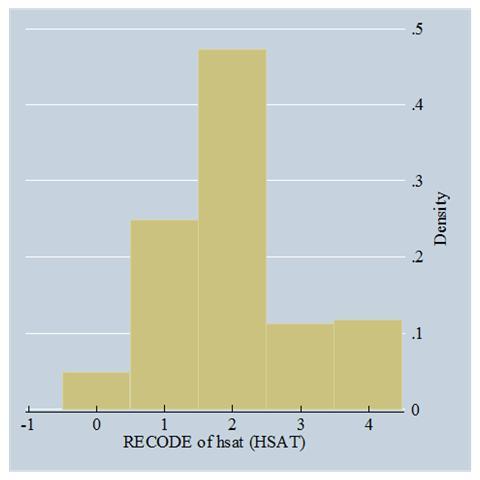| << Chapter < Page | Chapter >> Page > |
. recode hsat (0/2 = 0) (3/5 = 1) (6/8 = 2) (9 = 3) (10 = 4), generate(hsatnew)
Figure 7 shows the histogram of the new variable.

| Variable | 1984 | 1985 | 1986 | 1987 | 1988 | 1991 | 1994 |
| age | |||||||
| income | |||||||
| education | |||||||
| married | |||||||
| kids | |||||||
| _cut1 | |||||||
| _cut2 | |||||||
| _cut3 | |||||||
| _cut4 | |||||||
| Observations | |||||||
| LR χ 2 (5) | |||||||
| Prob>χ 2 | |||||||
| Log likelihood | |||||||
| Pseudo-R 2 |
Amemiya, T. (1985). Advanced Econometrics (Cambridge, MA: Harvard University Press).
Bourguignon, François, Martin Fournier, and Marc Gurgand (2007). Selection bias corrections based on the multinomial logit model: Monte Carlo comparisons. Journal of Economic Surveys 21 (1): 174-205.
Butler, J. S., T. Aldrich Finegan, and John J. Siegfried (1998). Does more calculus improve student learning in intermediate micro- and macroeconomic theory?" Journal of Applied Econometrics 13 (2): 185-202.
Chiburis, Richard and Michael Lokshin (2007). Maximum likelihood and two–step estimation of an ordered–probit selection model. The Stata Journal 7 (2): 167-182.
Dahl, Gordon B. (2002). Mobility and the returns to education: testing a roy model with multiple markets. Econometrica 70 (6): 2367–2420.
Dubin, Jeffrey A. and Daniel L. McFadden (1984). An econometric analysis of residential electric appliance holdings and consumption. Econometrica 52 (2): 345–362.
Greene, William H. (1990). Econometric Analysis (New York: Macmillan Publishing Company).
Heckman, James J. (1979). Sample selection bias as a specification error. Econometrica 47 (1): 153–161.
Jimenez, Emmanuel and Bernardo Kugler (1987). The earnings impact of training duration in a developing country an ordered probit selection model of Colombia's Servicio Nacional de Aprendizaje (SENA). Journal of Human Resources 22 (2): 230-233.
Lee, Lung-Fei (1983). Generalized econometric models with selectivity. Econometrica 51 (2): 507–512.
Maddala, G. S. (1983). Limited-Dependent and Qualitative Variables in Econometrics (Cambridge: Cambridge University Press).
Main, B. and B. Reilly (1993). The employer size-wage gap: Evidence for Britain. Economica 60 : 125–142.
McFadden, Daniel L. (1973). Conditional logit analysis of qualitative choice behavior. In P. Zarembka (ed.) Frontiers in Econometrics (New York: Academic Press).
Newey, W. K. and Daniel L. McFadden (1994). Large sample estimation and hypothesis testing. In R. F. Engle and Daniel L. McFadden (eds.) Handbook of Econometrics, vol. IV (Amsterdam: North Holland).
Riphahn, Regina T., Achim Wambach, and Andreas Million (2003). Incentive effects in the demand for health care: a bivariate panel count data estimation. Journal of Applied Econometrics 18 (4): 387-405
Schmertmann, Carl P. (1994). Selectivity bias correction methods in polychotomous sample selection models. Journal of Econometrics 60 (1): 101–132.
Vella, Francis (1998). Estimating models with sample selection bias. The Journal of Human Resources 33 (1): 127-169.

Notification Switch
Would you like to follow the 'Econometrics for honors students' conversation and receive update notifications?